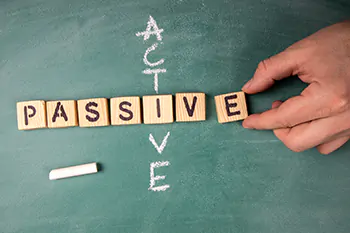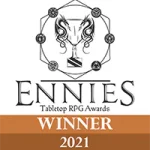Thinking Inside the Box
How To Write Boxed Text for Your Favorite RPG
Published May 2, 2021; Updated October 14, 2022
The writers and editors of dScryb are not the first to create boxed text, nor do we claim to be any authority. We have, however, written a lot of it, and over time we have learned a thing or two. We enjoy thinking about this charming niche within fantasy RPG writing.
This page is a collection of our thoughts, tips, and suggestions about writing boxed text. It may be of particular interest if you’re planning to use the Way of the Word, Scene Request, or Character Request features on the site; if you’re doing some prep writing for your homebrew campaign; or if you’re a roleplaying game writer.
If you’re the type of person that would rather listen than read, then definitely check out this Descriptions Masterclass with dScryb writer Alex Gray on the RPGBOT Podcast.
Short and Sweet
When it comes to boxed text, it takes more creative energy to write less, but it’s usually worth the extra effort. We consider a short scene to be 30 to 70 words and a long scene to be more than 100. Most of our favorite scenes are in the range of 50 to 70 words. Long boxed text can still be fantastic, but pretty quickly the word count starts delivering diminishing returns, then becomes an actual impediment.
We think these factors have something to do with it:
- Great boxed text is like poetry, and beautiful poetry has the feeling of being fleeting.
- If you view words as a scarce resource, then you’ll use them efficiently, which creates pithy writing.
- Boxed text isn’t just read, it’s read aloud (more on that below). The shorter it is, the easier it is to deliver with panache.
- Attention spans are short and getting shorter.
- Similarly, the longer the players listen to the Gamemaster narrate the boxed text, the more eager and anxious they become to jump into the scene and start interacting with it. Great boxed text gets out of the way just as quickly as it sets the stage, so that players never feel like they’re waiting to roleplay—which is, after all, two of the three letters in RPG.
Here are three examples of boxed text, each fewer than 70 words:
Bless
You flick holy water from your fingers, and it scatters into sparkling light that drifts against the wind toward those you protect. The blessing you grant settles about their shoulders like golden cloaks before vanishing.
Plateau
The plateau is a distinct and unmistakable sight, with soaring, sheer sides and a flat, sprawling top. It rises from the earth, evoking the image of a mountain with its top hewn cleanly.
Mage in Simple Clothes
The woman’s clothes are simple but their very practicality hints at a purpose: good boots, durable leggings, a fitted shirt with no sleeves to get in the way, and two hip pouches, each no doubt filled with spell components. She carries no weapons, but her posture has the confidence of someone who can pull fire from thin air and summon armor at an instant.
Three other examples, Charm Person, Vampire Spawn, and Unicorn, will also be referred to down below.
Lights, Camera, Description!
The subject of a scene, be it a lazy meadow, a busy tavern, or a vicious beast, does not stand still like the subject of a painted portrait. Moreover, the flow of time evidenced by the description of action keeps the excitement in the game up and makes for more interesting and credible scenes. Think video rather than photograph.

When it comes to living things, especially characters, physical features are great descriptors, but incorporating movements, manners of speech, or expressions, adds greater depth.
“He moves with the easy grace of a dancer.”
“She stands with a straight-backed rigidity borne of years as a soldier.”
“She speaks rapidly yet eloquently, her words laden with a natural curiosity.”
Furthermore, you can make the character act: “The half-orc has shoulder-length hair the shade of charcoal” is fine, but “The half-orc brushes a lock of their shoulder-length, charcoal hair behind their ear” feels more fun and dynamic—like looking at the character rather than just reading about them.
Or, take it one step further, as Matt Click suggests:
If the scene is of a character then, rather than describe them standing still, consider a scene in which they might feature. Make it fun and dynamic, even action-packed if it works thematically. If they’re a musician, describe them tuning their instrument or even performing (alone or to an audience); if they’re a skilled duelist, maybe they’re sharpening a weapon or even fighting; if they’re a magic-user, describe them conjuring a spell.
Natural landscapes may not skip and jump, but not even a lake at sunrise or moonlit desert lie perfectly still. Fish jump through rising steam to catch their breakfast; sandy dunes give way under tired legs and steal warmth through blankets at night (even entropy is action!).
The Five Senses
Most characters have four to six senses. We recommend trying to incorporate as many sensory descriptions as are reasonable without forcing it.
Ask yourself, how does the scene . . .
- look?
- feel?
- sound?
- smell?
- taste?
There are other natural senses to tap into: Proprioception is the sense of where your body is in space, including the movement and position of your limbs. Balance and the tilt of your head are other examples. The body and brain also detect levels of oxygen.
Of course, in fantasy there are often additional senses, though you’ll have to translate these into sensory experiences that your non-magical human players can relate to.
Active vs. Passive Voice
Despite some belief to the contrary, passive voice is not inherently bad (see, I just used passive voice). Passive voice is useful for giving the object of a sentence dominance over the subject, or for occluding certain details, but in general, try to use active voice. For example: “The city was protected by an order of brave knights” could be “An order of brave knights protected the city” or “An order of brave knights protects the city.” Active voice streamlines text and makes it easier and more exciting to read, because the subject of the sentence is the focus, and active verbs replace weaker “to be” verbs like “is,” “was,” and “are.”

Essentially, if you feel a sentence would read stronger in active voice, then do your best to make it active.
Avoid softening your verbs with the passive verb “to be.” For example: “The orcs were fighting” becomes “the orcs fought;” “the clerics are speaking” becomes “the clerics speak.”
Impressionism
A scene is not a place, nor a monster, nor a character—those things exist only in the collective imagination at the table. A scene is merely of these things. Resist the urge to describe every element that one might observe about the place, monster, character. Focus, instead, on the coolest, most interesting, most essential elements.
Matt Sernett writes:
There’s not really a manual for how to do what we’re doing with dScryb. A lot of it is just writing in a manner that gives the reader an emotional impression rather than focusing on the details. If you describe an emotion or emotive action and add a little detail, our imaginations fill in a lot of the rest. Often, they leave it unfilled, and that’s fine. If I describe, “A portly man with a pencil-thin mustache sweating with the effort of moving his luggage up the gangplank.” What color is his skin? What color is his hair? Is his shirt tucked in? Is he wearing a shirt at all? How about a hat? The gangplank of what: Is he getting on a steamer or a spaceship?
The truth is that a lot of those details don’t matter because context given before or after will fill them in, and the goal for dScryb text is to inspire ideas, not fully describe things.
Evoking a feeling and an overall impression should be at the core of any scene.
A picture is worth a thousand words, but you have neither. So, use the few words that you do have to paint a scene worthy of Monet.
Epistemology: Say “Awe”

Photo: Warner Bros.
We often say that boxed text describes the scene. This is true: You can write great boxed text that describes the characters’ observations and nothing more, as discussed above. These descriptions may elicit feelings—scorn, dread, joy—mental states that can feel very real to players because they are a product of their own mind.
Nevertheless, we posit that it’s more accurate to say that boxed text describes the experience of the scene. This is because, like their human players, characters are not simply an array of sensors. The perception of, say, a placid lake or a gathering storm, invariably creates a cognitive experience. And you can describe that experience, too.
Supplementing a physical, sensory description of the scene, or even fully replacing it, with a description of the characters’ cognitive experience of the scene, can be equally evocative. It can also help keep your boxed text short and sweet. What is the color of an “awe-inspiring sunset”? . . . It may not matter, specifically; in fact, one could argue it is better that it not be specific to avoid conflicting with players’ own interpretations.
As you begin to distinguish between sensory and cognitive experiences, you’ll notice that most boxed text blends them together, seamlessly and efficiently, just like the human mind. Take another look at the boxed text examples above:
- “. . . thinking about an old friend.” (memory)
- “. . . teeth far too long.” (comparison)
- “. . . a distinct and unmistakable sight.” (impression)
- “As it is, ‘unicorn’ must do.” (language)
- “. . . two hip pouches, each no doubt filled with spell components.” (inference)
A “negative” (not “bad”) use of epistemology is to posit a mystery, a hanging question, something that stirs curiosity, by conveying information that highlights either what the characters don’t know about the scene or that implies the limits of their senses:
- “You can’t quite place their accent . . .”
- “Another day passes on horseback, but the mountains seem just as high on the horizon”
- “Thundering trip hammers, each big enough for a giant to wield, pound in a regular beat, powered by unknown means.”
Care is required because it’s easy to go too far. The more pronounced the feeling or thought that you impose on the characters, the more player agency you steal . . .
Free Willy
There’s a spectrum of player/character agency, which is already well understood in the Gamemaster community. On one extreme end is narrative determinism: the Gamemaster tells a story involving the characters and the players listen helplessly as the events unfold.

Photo: Warner Bros.
On the other end is radical self-determinism: the characters reign supreme, bending the rules of the game and the laws of nature to their capricious whims.

Image: Warner Bros.
Neither of these extremes is particularly fun. But there are interesting discussions to be had near the middle of the spectrum, where reasonable people may disagree and the optimal position is more circumstantial.
Veteran game designer Shawn Merwin has also reflected on the medium of boxed text. Among many great pieces of advice, Shawn cautions against “steal[ing] player agency,” and even recommends moving from the second person to the third-person point of view to avoid this. So, taking his advice, instead of, “You look in fear upon the dragon;” consider, “The dragon is a frightful sight.” We encourage you to read more of Shawn’s thoughts.
Chris Sims, another expert on the subject, pointed to the dScryb scene A Negative Experience of Planar Travel—which reads, in part, “Just one excruciating moment more, and you’d beg all the gods for death, but just then it stops . . .”—and asked, rhetorically: “What if I’m playing a masochistic sorcerer? I’d be praying for the ride to keep going!” He has a point!
Context and subject matter are important variables. Spells are cast by characters, among others. They typically have some combination of verbal, somatic, and material components. If the player makes the executive decision for their character to cast a particular spell, then perhaps there’s an implied permission for the Gamemaster to describe, in the second person, the actions taken by the character to cast the spell, as in the examples of Bless and Charm Person above.
Just be aware of the trade-offs. In the section above, we suggested describing the cognitive experience of a scene to create an impression or feeling at its core, which can be effective and efficient. But there are characters (and maybe even players!) that would never, for example, find a sunset “awe-inspiring.” Taking the jump toward strong free will, or not, is up to you. But whether you have an audience of one or one million, we recommend that you think about those players when considering this question.
The Omniscient Narrator

Video: 20th Century Fox Television
We’ve recommended describing the character’s sensory and cognitive experiences to conjure a “theater of the mind” experience for your players. But because tabletop RPGs are not simulations—rather works of art that we play—there’s another technique to create evocative, fantastic scenes: provide information to the players that their characters would have no way of knowing. This is similar to the use of “dramatic irony” in literature.
This technique not only works to evoke feelings, such as the reverence of walking through a “forest older than the mountains,” but it’s also a great tool for world building. Here are three examples:
Atoll
Masses of coral rise from the sea, forming a chain of islands that peek above the waterline just enough to expose it to sunlight. Creatures roam these wisps of land—perhaps found nowhere else.
While qualified with perhaps, the possibility that the creatures are “found nowhere else” creates a sense of amazement.
Ruined Watermill
The half-sunken waterwheel peeks out of the mire, off its spokes beside this once prosperous mill […]
Describing the ruined watermill as “once prosperous” helps provide a forlorn sense of loss, while reminding the players that the place (and the world) existed before their characters came along.
Impact Crater Lake
In years past, a falling body smashed its way through the upper atmosphere and in its violence gouged out this enormous bowl shape into the earth before you. In the years since, a roving glacier or record rainfall has filled the crater with crystal-clear water, shimmering like mithral along its perfectly serene surface, protected as it is from the wind.
This scene contains a lot of exposition. If the history of the “falling body” mattered to the campaign, then learning it from the omniscient narrator, as opposed to discovering it through investigation, would not be fun. But if that’s not the case, and the location is only a landmark, then it’s a pretty fantastical one. Consider a version of the scene without any historical exposition:
Half-Filled Lake
An enormous bowl-shaped depression stretches out across the land. It is half-filled with crystal-clear water that shimmers like mithral along a perfectly serene surface, protected as it is from the wind.
Still cool, but different.
Verbal Component
Words can flow beautifully off the page when read only to sound ham-fisted when spoken. Boxed text is meant to be read aloud, so make sure to do so when drafting.
Editors’ Notes
Our editors are persnickety, and we like them that way. Here are three issues (plus a bonus thought) they encounter with regularity, so you may wish to look out for them:
Vagueness and Weakness
It’s tempting to be vague or use soft phrases, but it doesn’t assist the imagination. Strong wording is usually better. For example, compare “bodies lie here and there” or “people walk here and there” to “bodies were strewn about” or “people strode along . . .”
It may seem like a trivial difference, but even replacing the word “some” with “a” can improve a scene. For example, compare “some monster left tracks here” to “a monster left tracks here.” Neither sentence identifies the mystery monster, but the latter is more specific and, therefore, evocative.
Similar to “some,” the use of “thing(s)” or “stuff” to avoid specificity can detract from a scene.
Inconsistency
Lookout for the following:
- Mismatches of characteristics. For example, if a character’s hair is braided, it is unlikely to also be tousled, nor can clothing be simultaneously skimpy and protect every inch of skin.
- Mismatches of stance and action. For example, a creature cannot be standing at attention with arms by their side while rummaging in a backpack.
- Mismatch of sound effects and description. For example, boots “crunching” in slush.
Even in high fantasy, facts matter.
Another form of inconsistency is redundancy, such as in environmental descriptions: the mountains hide the horizon, but there’s also a blizzard obscuring the view.
Or, contradictory descriptions: the sky is blue but there’s a blizzard blowing (assuming that it’s not a spell over the players).
Repetition
Avoid repetition either of a word (“he looked down at the gate down below him”) or information already established (“Birds were singing in every tree. You walk a few paces listening to the birds singing.”).
And be wary of inadvertent homophones, such as “ring” and “wring,” which may be misheard. For example, “the hauberk is too large, and sweat mottles the red cloth ringing the squire’s neck.” Remember the verbal component!
Avoid use of the same word in different ways, for example, “the bells ring out in a town ringed by a stone wall.” While it’s obvious what is meant, it can create friction, which jars the reader out of the story (or the player out of the game) as they try to untangle it.
Not That!
Eliminate the use of the word “that” in your text unless absolutely necessary. If you find you’ve written a sentence containing the word “that,” try removing the word—if the sentence still makes sense, leave it out. For example, “Historical fantasy can be set in a world that is similar to our own, with cultures that are similar to real-world cultural groups” can easily be changed to “Historical fantasy exists in a world like our own, with cultures similar to real-world cultural groups.”
Concluding Thoughts
Boxed text is found in nearly every published adventure book. This speaks to its usefulness. When done well, players focus on the inspiring image in their minds, and all the actions and dialogue they will improvise when the narration ends—not on the text or its narration.
Keep it short and active. Caress the senses, coax the mind. Leave an impression. And don’t steal player agency (maybe just borrow some occasionally).
We recommend you not oversaturate your campaign with boxed text. When you’re narrating, nobody is roleplaying.
None of us learned this overnight. It takes time and practice to master any skill. Even with the writers’ vast experience, every scene has been reviewed by one or more editors before being published.
Recommended Reading
Writing Craft Books and Resources:
The Elements of Style by Strunk and White
The Elements of Eloquence by Mark Forsyth
On Writing Well by William Zinsser
Make a Scene by Jordan Rosenfeld
Writing Fantasy & Science Fiction by Orson Scott Card et al
Flash Fiction Online and other sites and magazines that publish flash fiction
Quick Fiction, a journal run by Pamela Painter
Telling Writing by Ken Macrorie
To see the craft in action, check out these published works:
Something Wicked This Way Comes by Ray Bradbury
The Last Unicorn by Peter S. Beagle
The Wind in the Willows by Kenneth Grahame
Watership Down by Richard Adams
The Old Man and the Sea by Ernest Hemingway
The Grapes of Wrath by John Steinbeck
The Time Machine and The Invisible Man by H.G. Wells
The Swords of Lankhmar by Fritz Leiber
Human Wishes by Robert Hass (especially the prose poems)
The Penguin Book of the Prose Poem, edited by Jeremy Noel-Tod
Wishful Thinking by Frederick Buechner


